William A. Balk, Sr.’s “Wartime Experiences of a Colorblind Navy Pilot—4”
“When I got down to 1,000 feet, I decided we’d had about enough, so I fired the rockets at God-knows-what target, then headed for the deck with the throttle wide open. These Avengers were redlined at about 300 knots, but I’m sure we exceeded that as we streaked across that town at tree level. In a few seconds, we were back over open water and safe, but it was a while before anyone said anything. Then Edinger said, ‘Wow.’ Al Pagnotta said, ‘Yeah.’ The Army guy said, ‘The happiest moment in my life was when you fired those rockets and started to get the hell out of there.’”—By William A. Balk, Sr.
Dispatches from The Esso Club
By Ted Balk
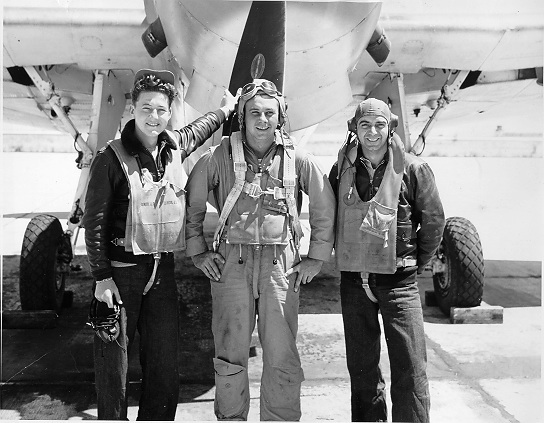
Note by Ted Balk: This fourth installment of my late father’s memoir continues the saga of his wartime experiences as a Navy pilot. Previously published installments on Weekly Hubris are: Installment 1—Foreword & Preface; Installment 2—Shakedown Cruise to Guadalcanal; and Installment 3—Invasion of Palau (Part One).
CENTRAL South Carolina—(Weekly Hubris)—6/30/2014—
CHAPTER II
INVASION OF PALAU
(Part 2)
On another occasion, I had been flying an Army observer over their operation on Anguar, which was a pretty dull mission. I never understood why we had to take Anguar in the first place because the Japs had only a few troops there and, once we took Peleliu, they were completely cut off and could do no damage. I suspected that this was to placate General McArthur because he thought he was getting shortchanged in this operation.6 Anyway, after we put in our required observation time and were relieved of that duty, we flew back to Peleliu looking for something to use our rockets on. For safety reasons, we generally avoided landing on the carrier with a full load of ammunition, but we didn’t like to jettison it if we could find a useful target.
When we couldn’t drum up any business on Peleliu, the Army observer suggested we fly up to the town of Koror and unload our rockets there. I told him that we had been warned to stay out of Koror. Halsey’s pilots had reported severe anti-aircraft fire when they tore up all the planes the Japs had there in late August. This elicited some snide comments about how the Navy did things compared to the Army, so I gave in and said, “OK, if you’re sure you want to do this, we’ll do it, but it’s not going to be pleasant.” I figured it was going to be rough, but it would probably scare him a lot worse than me and my crew, Edinger and Pagnotta. We started climbing as we left Peleliu and, by the time we got to Koror, we were at about 10,000 feet, which was a lot higher than we had been in a long time. I needed as much speed as possible when we pulled out of the dive at low altitude so that their smaller caliber guns would have difficulty tracking us when we were in close to them.
It was late afternoon, just before sundown, and the town was already in shadow while we were in brilliant sunshine. We were circling just out of their range and not making any threatening moves toward them, so everything was quiet on the ground. I asked the Army guy again if he was certain he wanted to do this. He said, “Sure, go ahead.” I dropped a wing and made a short dive toward the town, then pulled out to see what would happen. Right away, you could see gun flashes on the ground, but all the flak was low and behind us. I gave the Army guy another chance to back out, but he was stubborn. I said, “OK, here we go.”
This time, the ground looked like it was infested with lightning bugs. There were gun flashes everywhere, at least 200. The flak started popping all around us but, by that time, we were going so fast I couldn’t turn to dodge it. Then, something brand new started floating toward us. It looked like giant onion balls. Some were purple, some were yellow, some were red, and some were white. They were everywhere, all mixed in with the flak. Later, we figured out that they were probably basketball-sized chunks of burning phosphorous but, at the time, they all looked to be about the size of giant beach balls. When I got down to 1,000 feet, I decided we’d had about enough, so I fired the rockets at God-knows-what target, then headed for the deck with the throttle wide open. These Avengers were red-lined at about 300 knots, but I’m sure we exceeded that as we streaked across that town at tree level. In a few seconds, we were back over open water and safe, but it was a while before anyone said anything. Then Edinger said, “Wow.”
Al Pagnotta said, “Yeah.”
The Army guy said, “The happiest moment in my life was when you fired those rockets and started to get the hell out of there.”
As we headed back to the ship, I saw another TBM in the near distance, and I knew he was close enough to have seen the whole thing, but I figured he was from another squadron so nothing would likely get back to the Marcus Island about this. I figured the Army guy wasn’t going to brag about how stupid we’d been, and I knew I wasn’t. The crew would probably talk about it, but the story would stay with the enlisted men and we wouldn’t hear any more about it.
I was wrong. It turned out the other plane was one of ours, and Dick Hyde was the pilot. When I got to the ready room, Dick was sounding off. Dick tended to get excited very easily and, when he did, he got red in the face and waved his arms a lot. Dick was raving about the stupidest thing he’d ever seen in his life and how nobody but the biggest damn fool in the world could possibly have flown through that much AA and he knew who it was and the Skipper ought to ground him for life and so on. Actually the Skipper thought it was funny and so did everybody else, but I did have to listen to a lot of advice for a week or so.
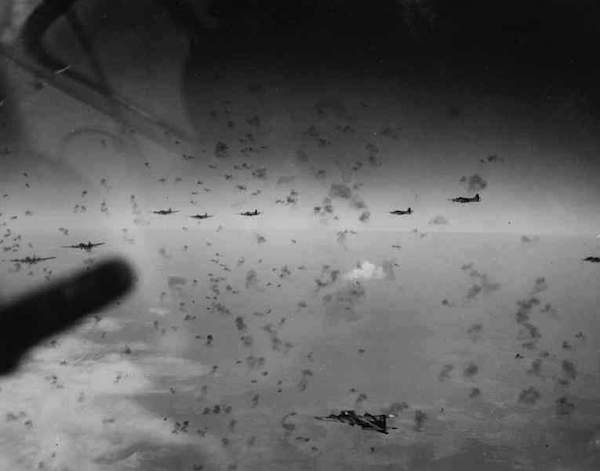
In reviewing my flight log, I was reminded of another incident that took place about a week prior to the Koror “attack.” It seems that someone in the higher command structure, either back in Pearl Harbor or San Diego, had decided there was a good chance that Halsey’s pilots had missed some of the planes when they tore up the field at Koror. They also had information that the Japs were preparing to launch a massive suicide attack against the American fleet in the near future. Their concern was that if there were flyable planes on Koror’s airstrip, they could be used against us. This was the first we had ever heard of a Kamikaze attack. The Admirals had decided that high altitude photographic flights would not be able to detect the planes because of the Japs’ ability to camouflage them, but that pictures taken at ground level would show them up in a profile very well. They decided that Admiral Sample’s group, CarDiv 27, should have the privilege of doing this. Admiral Sample decided that the Marcus Island, his flagship, was his choice to carry out the mission and so informed Captain Greber, who passed the responsibility on to Commander McElroy, the ship’s Flight Operations Officer. McElroy in turn briefed the Skipper, Lt. Commander T.O. Murray, who was our squadron’s Commanding Officer. Guess who was at the bottom of the ladder?
For the mission, a very special camera was delivered to the Marcus Island with instructions on how to use it. Incidentally, I don’t know how I was chosen because Patton had gone to photography school and was supposed to be our squadron photographer. But to get back to this mission . . . the suggested plan was for me to fly as low as I could (5 to 10 feet would be OK), while Edinger, my radioman, would aim the camera out the side window of the radio compartment and click the shutter as fast as he could.
When I suggested that I would prefer to make the run at the highest possible speed to reduce the risk of being shot down, they didn’t object because the camera was designed to change frames rapidly. In addition, we would be using very fast film so the pictures would still be clear enough to get the information they wanted. We spent a lot of time making sure Edinger knew how to operate the camera so that nothing could go wrong so long as we didn’t get shot down. Then, it was decided that since they would have to launch and land us for this mission anyway, and it would only take us a few minutes for a photo run, we might as well make a regular ASP flight and then make the photo run. In other words, if we got shot down, at least they would have a successful ASP flight to show for the trouble of launching us.
My flight log shows that on September 13 I made a 4.8-hour ASP flight, unloaded two 350-pound depth charges on a designated target on Peleliu, and then made the photography run. We started the run several miles out to sea on the west side of the island, building up as much speed as we could (maybe 250 knots) and flying as low as we could (5 to 10 feet). Just as we got to the start of the airstrip, I called to Edinger to start shooting. He clicked the camera as fast as he could, and we streaked across the field. I don’t know if anybody shot at us because I had to keep looking ahead to keep from flying into the ground. We came out over the water on the east side of the island and relaxed. The flight home and the landing were routine and Edinger turned in the camera for the film to be developed. We were bragging about how lucky we had been until a couple of hours later, when we got the bad news. The film was blank! Jim had forgotten to take off the lens cover.
The next morning, bright and early, we went out and did the same thing all over again. This time we got the pictures, but there were no planes on the field.

By this time, most of us in the squadron had been on active duty in the Navy for at least two years. At no time during this period did I recall any instruction or policy on ethical conduct in relation to the enemy. The tenor of the times was that the enemy was evil, and anything you could do to hurt him was legitimate. We had no illusions about how we would be treated if we became POWs and while flying this low we would have little chance of avoiding capture if we went down. I mention this not as justification for the following episode, but rather as an example of what can happen in a combat situation.
After the Marines had firmly established the beachhead and begun advancing inland, our flights with the Marine observers aboard were expanded accordingly. About the only way the Japs could be reinforced on Peleliu was by water from the islands further north; consequently we spent a lot of time patrolling that area.
On one of these patrols, we spotted a person swimming between two islands. He was completely nude and swimming face down but, based on his haircut, he was obviously Asian. His general body structure also suggested he was Oriental, and both the Marine and I agreed “he” could be a she but we couldn’t tell for sure.
This was all reported to the ground-air coordinator and then we went about our business. Some time later, the coordinator called us back and wanted to know what the swimmer was doing now. We checked and reported that he was just swimming around and didn’t seem to be going anywhere. (When we left him, we were hoping he’d head for one of the small islands and get himself or herself hidden.) The coordinator then wanted to know why we thought it might be a woman. We said it was just something about the body shape that suggested that possibility, but it wasn’t as clear cut as with women back home. He came back with a statement to the effect that we must have been out here too long if we couldn’t tell the difference between a man and a woman anymore. We told him that he or she was swimming face down and wouldn’t turn over. He came back that it was probably a man and he was carrying messages, so go on and shoot him.
Well, that amounted to an order and didn’t leave us with many alternatives. The Marine observer and I discussed the situation between us and decided we’d stall as long we could. Maybe the swimmer would head for an island, and we’d give him or her the chance to run for cover before we’d start shooting. It wasn’t long before the coordinator was back on the radio wondering if we had finished the job and, if not, what was holding us up. We told him what we were doing and he ordered us to quit stalling and get the job done. The swimmer was still making no move to take cover, so we decided that we’d done all we could to give him a chance and we’d have to carry out orders.
In order to fire the wing guns, they would have to be armed (cocked) by means of a hydraulic connection inside the cockpit. This is a safety precaution to prevent accidental firing aboard ship or elsewhere. I activated the guns and started a strafing run. The guns didn’t fire. I tried again, still with no results. Again. No results. By then, the Marine observer in the plane wanted to know what I was doing. I told him the problem and he, of course, thought I was just delaying things. He said I had better quit stalling and get this over with. I said I would if I could, but I couldn’t. When we reported this to the coordinator, he let us know what he thought about us, then said if we didn’t know how to make the wing guns work to use the turret. This meant I’d have to put the burden on Pagnotta. So I said, “Al, I guess it’s up to you.”
He said, “Yes, Sir.” From his tone, I knew he thought I was stalling, too.
In order to use the turret gun this way, we had to fly in a tight circle with one wing down so the gun could be depressed low enough for it to hit an object on the surface. We had practiced this maneuver a number of times and were good at it, but we had never thought we’d have to use this procedure this way. We got the plane in position, and I told Al to let him have it. He made a short burst and the water erupted around the swimmer so that he was completely obscured. In a few seconds it cleared up; he was still swimming. I told Al to hit him again. The same thing happened. I said to hold off a minute and maybe he would turn over; then, if it were a woman, we would call it off. The swimmer kept swimming face down. Another burst and a red stain showed up immediately. We reported to the coordinator that we’d accomplished the mission, and we’d run out of time and were returning to the ship.
As soon as we’d said that, a plane from another squadron reported in for duty with the coordinator and stated that they had been monitoring our conversation and would like to check on the situation since we were leaving. He further stated that he wouldn’t have any trouble getting his wing guns charged. The coordinator encouraged him to check it out and, in a few minutes, the other plane reported gleefully that we hadn’t hit our target. He was still swimming, and they would finish him off in short order. I told Edinger to get us on another frequency—we had heard enough of that. We headed home. When we got back, I made sure that our ordnance chief, along with Pagnotta, checked the wing guns to verify whether or not the guns had malfunctioned. They verified the malfunction.7
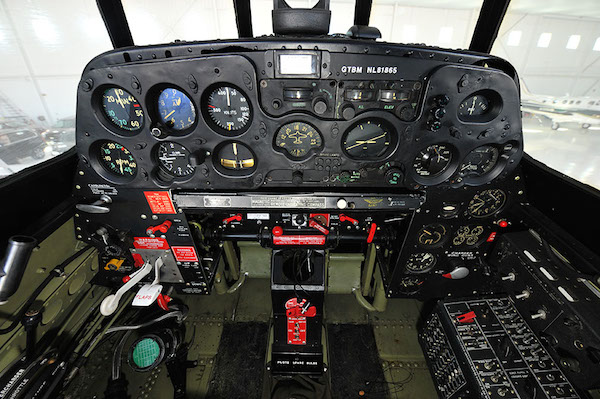
To be continued . . . .

End Notes for Chapter II
Note 6. Reason for Taking Anguar
My suspicions that the reason for taking Anguar was to placate General MacArthur by giving the troops something to do were not entirely justified. Anguar was large enough to construct a bomber strip, which could be used by the Army Air Corps to launch bombing raids on the Philippines, Formosa, and Okinawa in anticipation of invading these islands. Hindsight shows that even this did not prove to be ample justification. Bombers flying from this strip could never approach the effectiveness of Halsey’s fast carriers operating a few miles off the shore of these islands.
Note 7. On Killing Defenseless People
I don’t feel that our conduct involving the nude swimmer was unethical for the times. I do think that many of our modern guardians of military ethics would consider any comparable situation today as a glaring example of unethical military conduct and exploit it in the media for their own ends.
I think all four of us in the plane that day deeply resented being called on to act as executioners in that particular situation. It wasn’t just a question of killing someone; we knew that was our job. It was a question of shooting a totally defenseless individual who posed no direct threat to anyone or anything at the time. If we could have established the fact that we were dealing with a woman, we could have argued that she was obviously a non-combatant and therefore we had legitimate grounds for refusing to carry out the order to shoot her.
A comparable situation occurs when a pilot bails out of a disabled plane while in a dogfight. All the American pilots I know considered it unethical to shoot an opponent in that situation. As far as I know, none did; but the Japanese did on several occasions.
This episode also raises the question of an individual’s responsibility to execute an order with which he or she disagrees on moral or ethical grounds. The military is not and never should be a democratic institution. It is, and should be authoritarian and I hope will remain so. This does not mean that the thoughts and ideas and criticisms from junior officers and enlisted personnel should be repressed. If they ever were, I’m not aware of it. In fact, most of the conversations aboard ship involved criticism of everyone from the Commander-in-Chief in Washington on down to an individual’s immediate ranking superior. A lot of the criticism was valid but once an order was issued, it was incumbent on everyone involved to carry out the intent of the order to the best of his ability. To do otherwise could jeopardize the success of a mission and materially increase the risk to individuals involved. I am happy to say that I am not aware of any instance in which this occurred.
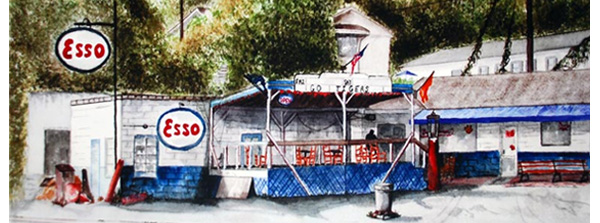
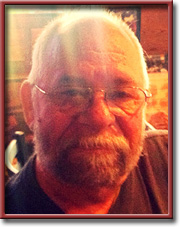
2 Comments
Anne Osborn Tomasso
Thank you for posting your stories.
Ted Balk
Thank you for reading, Anne. Our family has been wanting to find a way to get our father’s memoir on line for a While. We’ll compile it all into a single book when it’s all done.
Ted